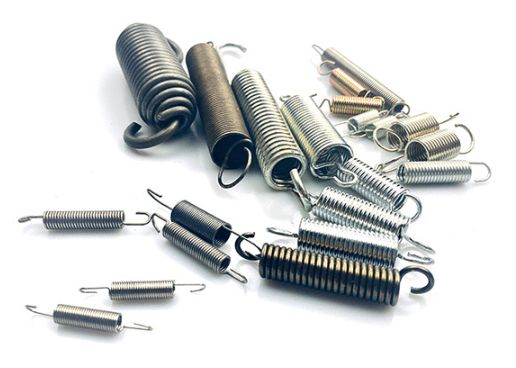How to Produce Tension Springs
Corps
Tension springs are a type of helical spring designed to withstand axial tension. When these springs are at rest, their coils are typically tightly wound with no visible gaps. In this article, we will delve into the materials commonly used to manufacture tension springs, the essential parameters to consider before production, and the intricate production process of these invaluable components.

Materials Utilized in Tension Springs
Materials for tension springs fall into two primary categories: metallic and non-metallic.
Metallic Materials:
Spring Steel:
Carbon Spring Steel: Common grades include 65Mn, T8, T9, etc.
Alloy Spring Steel: Typical grades comprise 50Crv, 55CrSi, 60Si2Mn, etc.
Stainless Steel for Spring: Typical grades involve 304, 12Cr18Ni9, 07Cr17Ni7AI, etc.
Copper Alloys: These encompass silicon bronze, beryllium bronze, brass, among others.
Nickel and Nickel Alloys: Varieties include pure nickel, nickel-copper alloy, nickel-cobalt alloy, nickel-chromium alloy, etc.
Other Special Alloys: High-speed tool steel, alloys tailored for elastic components, memory alloys, and more.
Common Non-Metallic Materials:
Gas and Liquid:
Gas (e.g., gas spring)
Liquid (e.g., oil)
Gas-Liquid Mixtures
Rubber and Plastic Fiber Reinforcement Materials.

Key Parameters of Tension Springs
Before designing and manufacturing tension springs, it's essential to consider several critical parameters, including:
Hardness
Wire Diameter
Coil Pitch
Inner Diameter
Outer Diameter
Length
The Production Process of Tension Springs
The production process of tension springs involves a series of meticulous steps:
Winding Forming:
Cold Rolling Method: Used for springs with wire diameters (d) ≤ 8mm. Typically, quenching treatment is not performed after winding; only low-temperature tempering is required to eliminate internal stress.
Hot Rolling Method: Employed for springs with wire diameters (d) > 8mm. These springs rolled in a hot state, require quenching and tempering at medium temperature after rolling.
Heat Treatment:
Most elastic parts undergo heat treatment post-forming to establish and maintain elasticity, making it a crucial step in spring production.
End Surface Treatment:
The end surface of the spring, rolled after forging and flattening at both ends of the material, needs grinding to stabilize the support surface of the spring end ring. This ensures verticality and roughness requirements are met.
Surface Treatment:
Surface treatment options include plating (e.g., galvanized, cadmium-plated, copper-plated), bluing or blackening through oxidation treatment, phosphating (creating a water-insoluble phosphate film on the metal surface), and protective coatings such as paint, asphalt, or plastic.
Packaging and Storage:
Manufactured tension springs are meticulously packaged in specialized containers designed to protect them during transportation and storage.
Conclusion
The production of tension springs involves careful consideration of materials, parameters, and an intricate manufacturing process. KENENG, a trusted enterprise in spring production, offers a range of spring types, including compression springs, tension springs, mold springs, and special-shaped springs, all customized to meet customer specifications. With a rich history in the industry, KENENG is committed to delivering high-quality, cost-effective springs tailored to your unique needs. If you require springs, reach out to KENENG for top-notch service and quality products.










commentaires